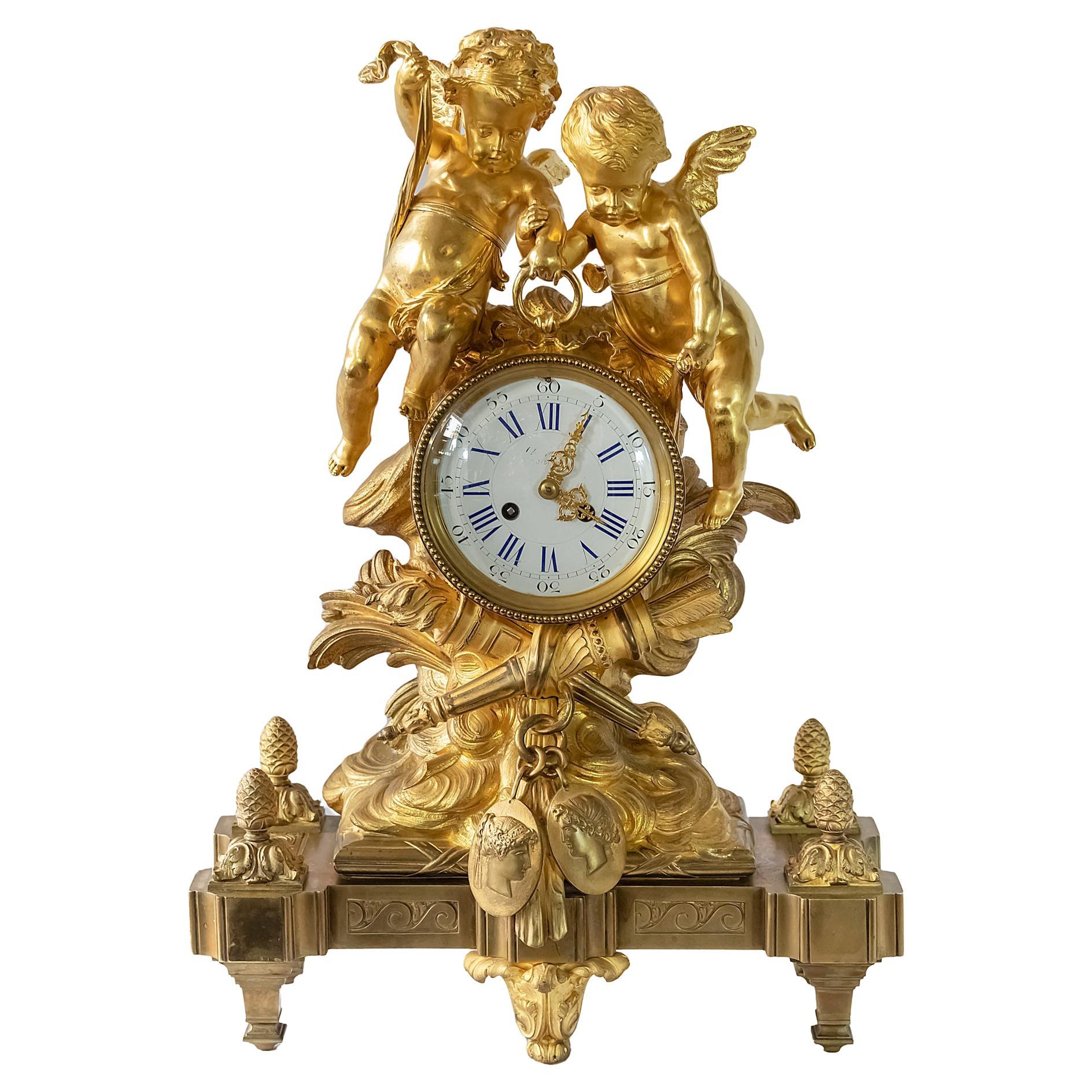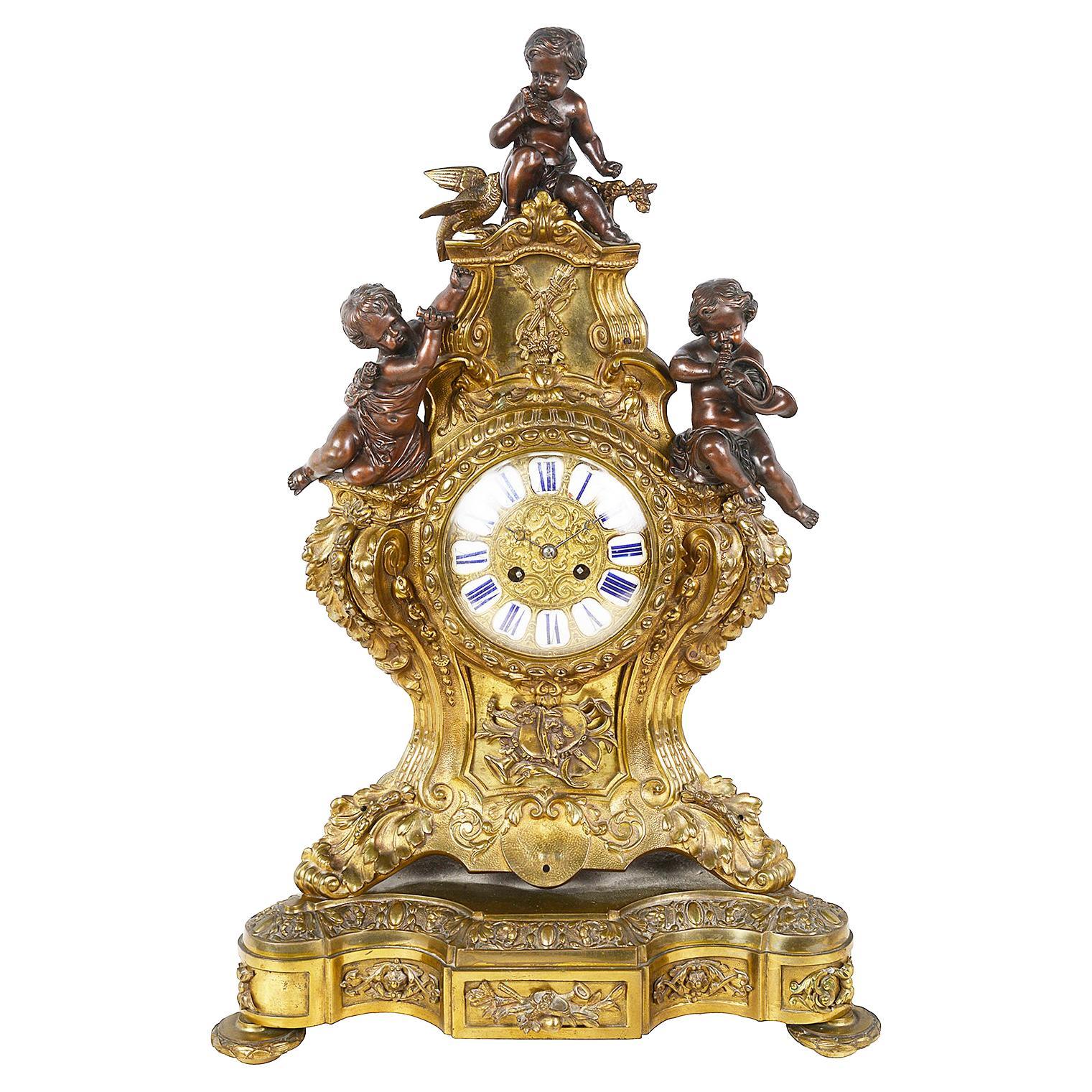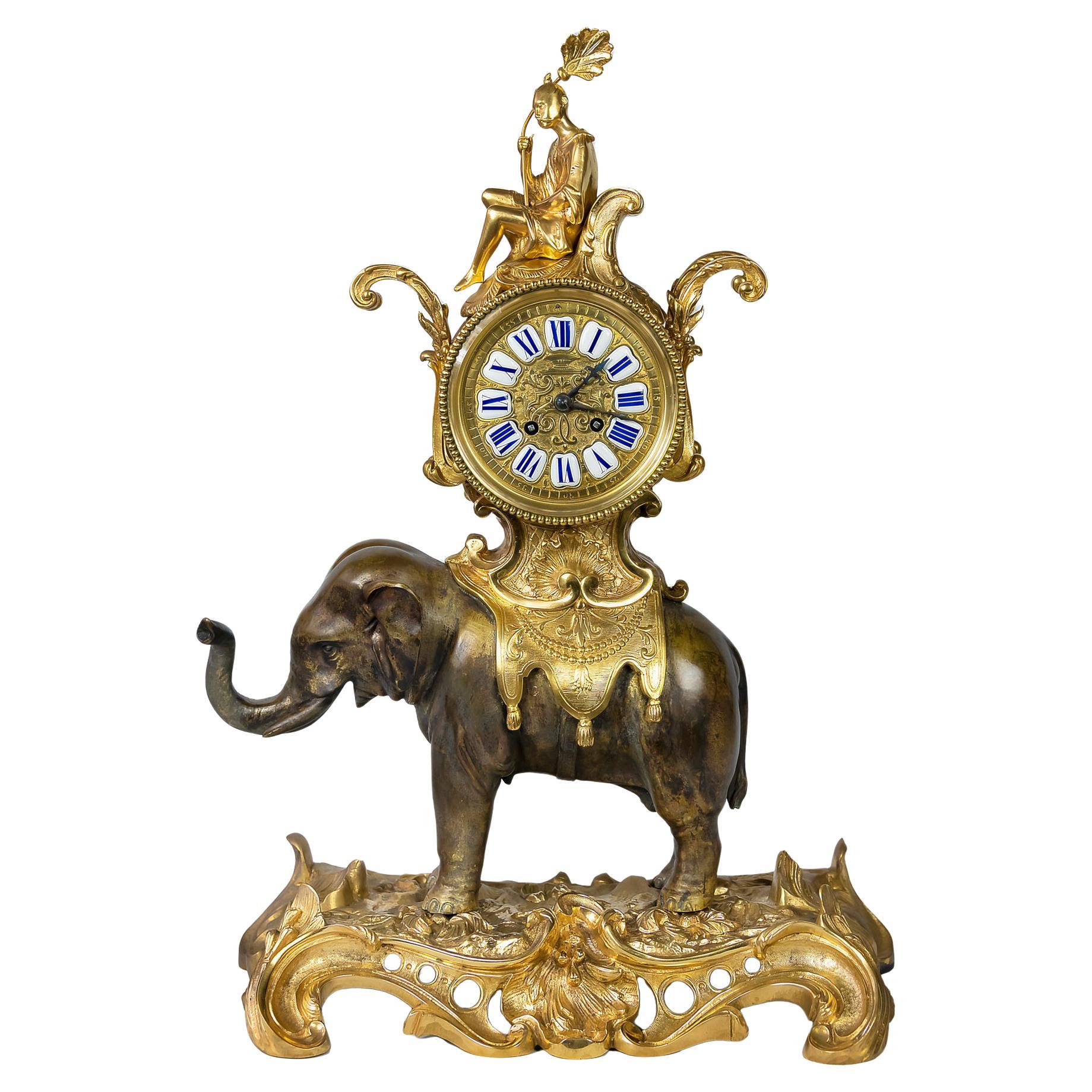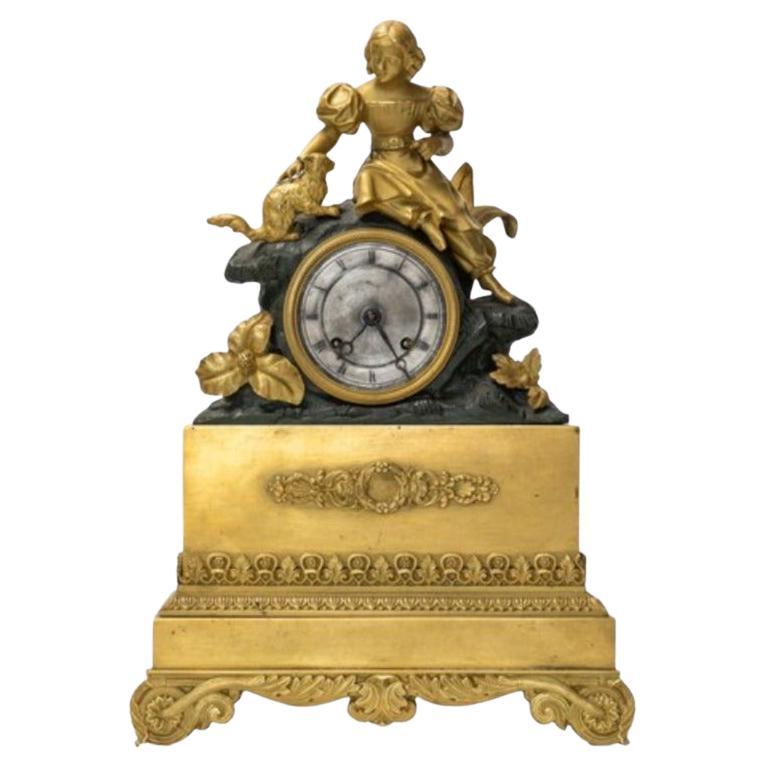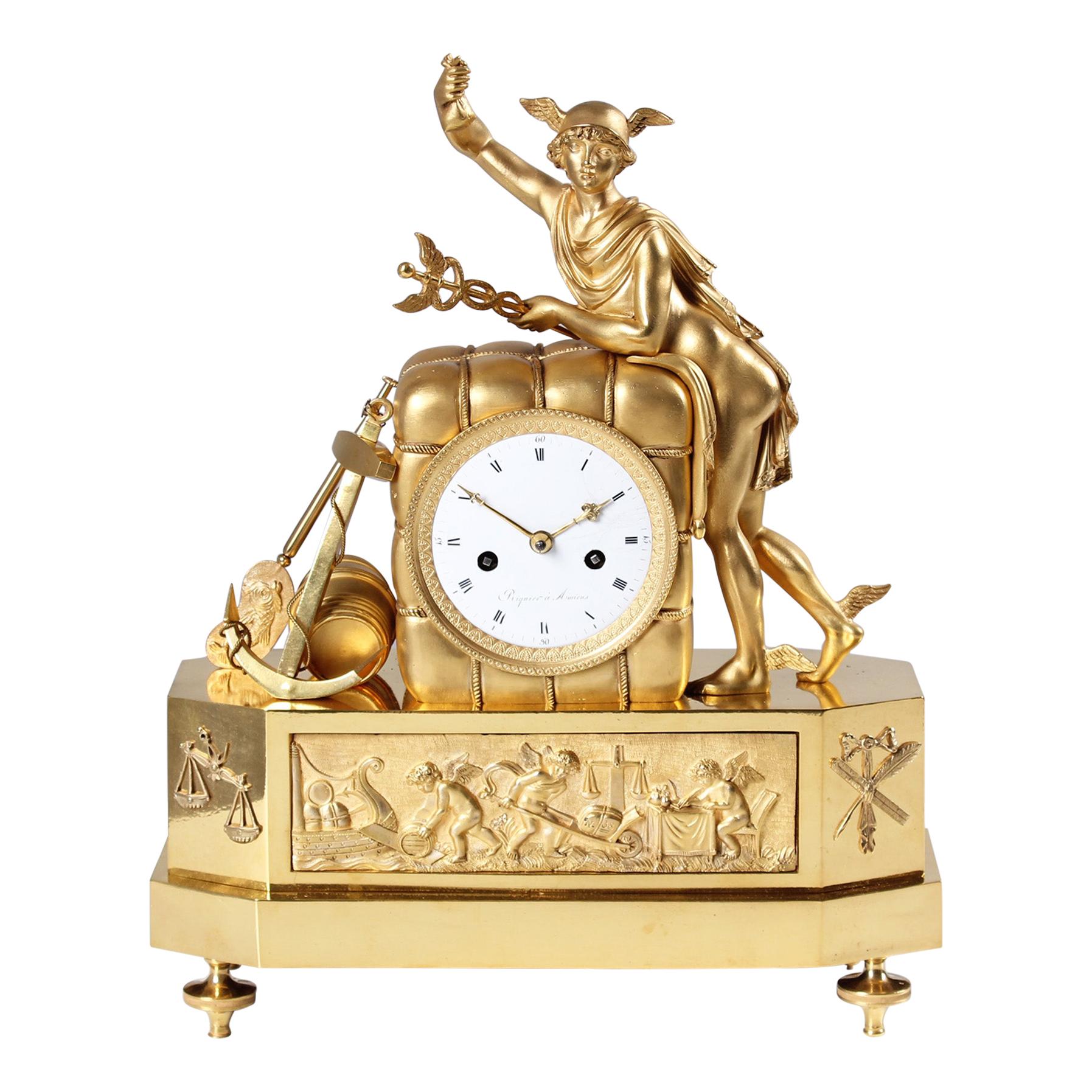Items Similar to 19th Century Miniatur Mantel Clock, Gare La Bombe, Cupido, France, Gilded Bronze
Want more images or videos?
Request additional images or videos from the seller
1 of 12
19th Century Miniatur Mantel Clock, Gare La Bombe, Cupido, France, Gilded Bronze
About the Item
Pendulette "Gare La Bombe"
France
gilded bronze
first half 19th century
Dimensions: H x W x D: 20 x 15 x 7 cm
Description:
Antique miniature mantel clock made of partly fire-gilded and partly patinated bronze.
Depicted is Cupid the god of love being shot from a cannon as a sign of fertility. The cannon is mounted in a bumper supported on rails.
In the center of the cloud of smoke created by the firing is the enameled dial.
On the front of the oval base is a plaque with the inscription GARE LA BOMBE.
Condition:
Good authentic condition of the gilding. Plaster wear on the edges of the base and partially on the cannon barrel.
- Dimensions:Height: 7.88 in (20 cm)Width: 5.91 in (15 cm)Depth: 2.76 in (7 cm)
- Style:Empire (Of the Period)
- Materials and Techniques:
- Place of Origin:
- Period:
- Date of Manufacture:1820
- Condition:Wear consistent with age and use.
- Seller Location:Greven, DE
- Reference Number:1stDibs: LU5419227444032
About the Seller
5.0
Platinum Seller
These expertly vetted sellers are 1stDibs' most experienced sellers and are rated highest by our customers.
Established in 2014
1stDibs seller since 2020
114 sales on 1stDibs
Typical response time: <1 hour
- ShippingRetrieving quote...Ships From: Münster, Germany
- Return PolicyA return for this item may be initiated within 14 days of delivery.
More From This SellerView All
- 19th French Empire Mantel Clock, Pendule, Mercury, Gilded Bronze, circa 1815Located in Greven, DE19th century French pendule, mantel clock - Mercury the messenger of the gods France Bronze gilded Empire around 1815 Dimensions: H x W x D: 37 x 30 x 10 cm Description: French Empire...Category
Antique Early 19th Century French Empire Mantel Clocks
MaterialsBronze
- Early 19th Century Mantel Clock, Firegilt Bronze, Paris circa 1810Located in Greven, DEVery rare "Au Bon Sauvage" mantel clock France Fire-gilt and patinated bronze Empire around 1810 Dimensions: H x W x D: 34 x 41 x 13 cm Description: Extremely rare French bronze m...Category
Antique Early 19th Century French Empire Mantel Clocks
MaterialsBronze
- 19th Century Mantel Clock "Astronomy", France circa 1830Located in Greven, DEAntique mantel clock on the theme of astronomy France Bronze Charles X around 1830 Dimensions: H x W x D: 48 x 19 x 10 cm Description: Unusual and beautifully crafted bronze mante...Category
Antique 19th Century French Charles X Table Clocks and Desk Clocks
MaterialsBronze
- 19th Century French Ormolu Mantel Clock, circa 1840Located in Greven, DE19th Century French mantel clock France (Limoges) Ormolu around 1840 Dimensions: H x W x D: 37 x 22 x 10 cm Description: The bronze, cast in relief and then fire-gilded, stands on...Category
Antique 1830s French Charles X Mantel Clocks
MaterialsMarble, Bronze, Ormolu
- Early 19th Century Ormolu Mantel Clock, Atala freeing Chactas, Paris, circa 1810Located in Greven, DEMantel Clock "Atala and Chactas" Paris Bronze (fire-gilt and patinated), enamel Empire around 1810 Dimensions: H x W x D: 40 x 32 x 11 cm Description: Very rare and extremely high quality French mantel clock, so-called Pendule Au Bon Sauvage. Depicted are scenes from the love story "Atala or the love of two savages in the desert" written by Francois René Vicomte de Chateaubriand in 1801. At the beginning of the 19th century, this was probably the most famous love story in Europe, but today it has been forgotten. The story, set in present-day Louisiana (USA), is roughly rewritten about the forbidden love between Chactas, a young Indian, and Atala, the beautiful daughter of a Spaniard. Chactas is captured in a battle between two Indian tribes, chained to a palm tree and is to be sacrificed. Atala wants to save his life and convert him to Christianity. She unties him from the palm tree at night and they flee together into the wilderness of North America. Their love for each other grows stronger and stronger and they have prospects for a future together. The story takes a tragic turn when Atala, who must remain a virgin due to a vow made by her mother, can no longer withstand the conflict of her feelings and commits suicide. The main group of characters thus shows Chacta's liberation through Atala. Atala is leaning against a pile of logs. The animal fur thrown over the logs and the weapons leaning against the stack on the right give the impression of a night camp. The bronze is of rarely beautiful quality, finely chiselled and makes the scene appear very lively. The contrast of fire-gilded and patinated bronze adds tension to the composition. In the base we see the Entombment as the end of the tragic love story. This bronze work is also very detailed, the interplay of bright and matt gilding makes the flat relief appear much deeper than it is. The depiction of the mantel clock presented here shows that the exotic was only known from stories and that the bronzier had his own ideas about the appearance of this distant world. The Indian, for example, has very European facial features and his skin was not black in reality, of course. The palm tree was also certainly not found in the North American wilderness. The heart of the clock is a French pendulum movement, integrated into the wooden pile, with an eight-day power reserve and a lock plate striking a bell on the half and full hour. The pendulum is suspended on a thread, typical of the period. The classically shaped hands, so-called Breguet hands, are also typical of the time. The enamelled dial has black Roman hour numerals, Arabic quarter hours and bears the signature: Le Roy hr. de Madame A PARIS. Interesting facts: The period from 1795 to about 1815 saw the creation of probably the most spectacular group of bronzes: The "Au bon Sauvage" pendulums - depictions of the "Noble Savage". Today's viewers react to these objects with both fascination and irritation. Enthusiastic on the one hand about the obvious quality of the detailed bronzes and the allure of the exotic, on the other hand distanced and cautious because of the possible discrimination that is suspected behind them. The ambivalence of this feeling motivates the search for the conditions of origin of these pendulums. Europeans found their new ideal of the natural man primarily in fictional and realistic travelogues about the Indians of North America...Category
Antique Early 19th Century French Empire Mantel Clocks
MaterialsOrmolu
- Empire Mantel Clock - La Bibliotheque, Ormolu, France, Paris, circa 1820By Le RoiLocated in Greven, DEMantel Clock - La Bibliotheque - In the study room Paris fire-gilt bronze, enamel Empire around 1820 Dimensions: H x W x D: 38 x 28 x 19 cm Description: Scenery mounted on an oval...Category
Antique Early 19th Century French Empire Mantel Clocks
MaterialsBronze
You May Also Like
- Antique 19th Century French Gilded Bronze Mantel ClockLocated in Vilnius, LTLarge antique 19th century French gilded bronze mantel clock surmounted with two angels holding the dial. The enamel dial numerals are hand...Category
Antique 19th Century French Mantel Clocks
MaterialsBronze, Enamel
- 19th Century Gilded Ormolu and Bronze Mantel ClockLocated in Brighton, SussexAn impressive late 19th century French gilded ormolu and patinated bronze mantel clock. Having three putti mounted to the top each playing musical instruments. The clock having an ei...Category
Antique Late 19th Century French Louis XVI Mantel Clocks
MaterialsBronze, Ormolu
- French 19th Century Louis XV Gilded Bronze Elephant Mantel ClockLocated in Vilnius, LTFrench 19th century Louis XV stile gilded bronze mantel clock created in the manner of Chinoiserie. The base is in gilt bronze with the patinated bronze sculpture of an Asian elepha...Category
Antique 19th Century French Louis XV Mantel Clocks
MaterialsEnamel, Bronze
- Antique French Early 19th Century Charles X Gilded Bronze Mantel ClockLocated in Victoria, BCThis antique mantel clock features blue hands and a fully gilded rim. The heavily ornamented base on which the clock sits is also gilded. A beautiful girl in a dress with puffed slee...Category
Antique Early 19th Century French Charles X Mantel Clocks
MaterialsBronze
- Bronze Mantel Clock, 19th CenturyLocated in Madrid, ESTable clock. Marble and bronze, 19th century. Table clock with Paris box machinery made of marble and bronze and with porcelain plates applications with roc...Category
Antique 19th Century European Neoclassical Mantel Clocks
MaterialsBronze, Other
- Fine Quality 19th Century French Gilded Mantel ClockLocated in Brighton, SussexA fine quality 19th century French gilded ormolu and Breccia marble mantel clock, having a two handled lidded urn finial, foliate swags hanging down to ribbon decoration above the wh...Category
Antique 19th Century French Louis XVI Mantel Clocks
MaterialsBreccia Marble, Ormolu
Recently Viewed
View AllMore Ways To Browse
Clocks Made In France
Gilded Clock
Gilded Mantel
French Clocks From The 19th Century
Antique French Clocks 19th Century
Gilded Bronze Signed
Gilded French Clock
Bombe 19th Century
Gilded Bronze Clocks
Early 19th Century French Clock
Gilded Mantel Clocks
French Gilded Mantel Clock
Cannons
Antique French Plaster
Mantel Antique Bronze Clocks
Gilded Plaster
Antique French Bronze Mantel Clock
Gilded Bronze Mantel Clock
